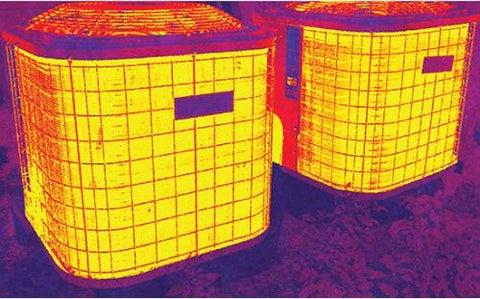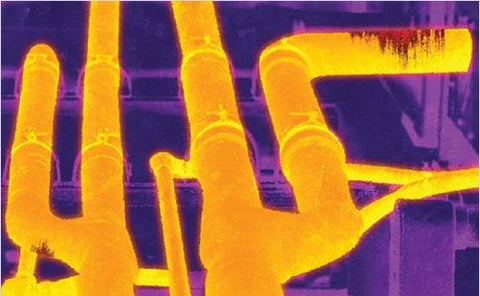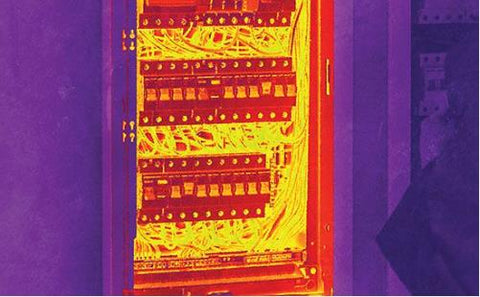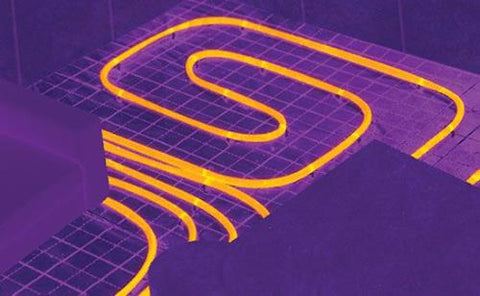HVAC systems exist nearly everywhere and are essential to large buildings as they regulate the temperature and supply clear air to the inhabitants. Beyond the larger buildings, HVAC is an integral part of home residents including apartments, motels, hotels and office buildings.
While these systems play a critical role, they also need to be maintained regularly and properly in case a fault develops and kills the whole system. For owners of HVAC systems this is just the beginning of their problems as you have to consider staff being unable to go to work if there is inadequate ventilation or regulation of temperature. Not to mention replacing the whole system.
Faults can develop at any time before the system fails, they are often invisible to the regular inspections conducted with the naked eye. This is where a thermal camera comes into play. Since faults can come in many different shapes and forms a thermal camera can reveal most of the common faults, best of all, it can do it from a safe distance.
CONDENSER COIL
Condenser coil is an essential part of a HVAC system as its function is cooling down the air by removing the heat and condensing the refrigerant. Overtime with regular use, the condenser coil builds up dirt and grime which will adversely affect the operational performance.
The first and most noticeable effect will be a drop in efficiency which means the unit will need to work harder for the same results. The dirty and clogged condenser coil loses its efficiency to transfer the heat outside and users may turn to lower the temperature more on the unit to make it work harder for the same cooling effect. This will drive up costs for operating the unit under the same conditions.
Another consequence of a clogged condenser coil is that it will drastically reduce the operation life of the HVAC unit through wear and tear. The additional stress in which the unit has to operate through will impact its overall functionality and eventually break it.
A thermal camera can reveal to an inspector a clogged up condenser coil without needing to take it apart and thoroughly inspect it. This is achieved with the thermal imagery showing that the coils are experiencing abnormal temperatures. This normally means that they are clogged up and hence there is a buildup of heat in this area. A quick inspection with imagery evidence, your reports will go a long way in explaining to an owner that they need a professional to take apart and clean the coil to save them a huge amount of costs in the long run.

LEAKING DUCTS
Leaking ducts are a significant and common issue with HVAC systems that are overlooked. The leak is defined as when AC units are operational and distribute conditioned air, yet it leaks out through cracks or holes in the duct before reaching the desired location. Here are 3 commons types of leakages through the duct:

Supply Leakage
The ducts are where the conditioned air passes through in order to reach the desired destination. At any point in this duct there could be a leak from a small or large hole which can be very hard to find with the naked eye. In addition, the holes in the ducts don’t necessarily mean they let conditioned air escape, the air from outside could be sucked in. This is caused by something called the Venturi effect, where the airflow inside the duct can suck in air from other parts of the house and the problem is the unconditioned air as well as unwanted dust that can cause more problems than a broken down HVAC system, it can lead to mold developing in hard to identify areas and create adverse problems for the human health.
Equipment Leakage
The coil cabinets and the parts all closest to the fan will have seams, gaps for the refrigerant lines to go through are all areas for potential leaks. The closer the proximity to the fan the greater the pressure and therefore small holes or unclosed parts will have greater impact on the HVAC system.
Return Leakage
The return ductwork are the vents that draw in unconditioned air from around the house. Normally they are strategically placed in a clean area free from dust and harmful air. But if a leak were to occur anywhere along the way, then the dust and unwanted air could be sucked in. This is particularly problematic if the leak occurs in the attic where the air is particularly bad, the air here is often dusty, hot and humid.
HVAC systems won't be able to filter out all of these dust particles or eliminate the rush of extra humidity, even worse still is if the leak appears after the filters which means 100% dusty and hot air will flow out of AC units.
Identifying the small holes in the ductwork can be time intensive and require a lot of equipment and manpower. Thermal cameras can do this job better without all the extra equipment. If there is a small leak anywhere along the duct work, there will be a temperature difference by the leak which will be in contrast to the rest. Since thermal cameras have high sensitivity, they will be able to pick up this difference in temperature and display it clear as day. A quick inspection of that area to confirm it and then you will have identified the leak.
ELECTRICAL PROBLEMS
It should come as no surprise that HVAC systems will also suffer from electrical problems. Here are 3 common problems that can occur:

Wiring
The wiring in HVAC systems are vulnerable to fraying and corroding, more so if they have been badly wired and are exposed to the elements. Over time the corrosion will take a toll on the wire and it will fail, cutting off the system. Professionals are better equipped to diagnose faulty wires and replace them safely.
Capacitors
Capacitors are essential components for HVAC systems as they store electricity and are used to start motors. In most HVAC systems there are three motors; the compressor motor, the blower motor, and the outdoor fan motor, if any of these fail then the whole system will fail to start. A good sign to look out for is that the capacitors will make some clicking noises when it’s starting to fail. The best solution is to call in a professional to replace it as there are some capacitors which have oil leaks which are particularly dangerous to replace.
Circuit Breaker
If you find that the circuit breaker keeps tripping and shutting off the HVAC system, then there are two main reasons for this; the system is drawing too much power and risks overheating or there is a problem with the breaker.
It is very important that if the switch has flipped that you do not reset it over and over again as you will risk doing permanent damage to the system, as in the first scenario it could be there is too much electricity going through the system. Before you call in a profession you can do the following once to check:
• Turn off the AC unit at the thermostat
• Go to the switch and turn the AC breaker switch ON
• Wait at least 30 minutes for the AC internal breakers can reset
• After waiting 30 minutes, turn the AC unit to cool
If it runs fine after this test then it should be good to go, if it still short circuits immediately then it's definitely time to call a professional. However, if there is some time before it short circuits again then there is one last thing you can try before calling the professional. Take a look at the air filter and check if it's blocked with dust and debris, as these pollutants will gather up over time they make the fans work harder to draw air to pass the filter. Try cleaning or replacing this air filter and repeat the above process one more time. If this fails then it's really time to call the professional who can quickly identify overheating issues with a thermal camera.
RADIANT FLOOR HEATING
After installing radiant floor heating you would expect to see your utility bills to be lower than when you used radiators to heat up your room, after all it takes less energy to heat up a room now compared to using efficient radiators. However if they fail to work or even reach the desired temperature then you need to diagnose the problems and fix it.
The 2 most common problems you will come across are:

Electrical Problems
Electricity is needed to start the pump as well as other components. If the wiring between these components becomes frayed or loose, you will experience electrical problems. This will result in the heating system not working at all or working inefficiently.
Leaks
If there is a leak in the radiant floor system not only is the system compromised you may find that the water is causing other unseen issues. The most likely scenario is the leak happens at the apex of the system which makes it harder to spot. A good way to see if you have a leak without a thermal camera is to look at the water pressure gauge.
Using a thermal camera, you can see which part of the floor heating is uneven in temperature and check those areas for leaks. Alternatively, if there has been a leak for some time, you can also look at the floor/ceiling to see uneven temperature spots. The area where there is a leak and is wet will show a colder area.
ADDITIONAL BENEFITS TO INSPECTORS
In many instances inspectors are called in to inspect HVAC systems and after conducting a thorough check they are able to quote a price. However, this is the hard part, as some customers are wary about the need to fix or replace parts of their expensive system.
A thermal camera can easily convince customers where the problems are through clear thermal images. If they can see what a professional inspector can see then they are more likely to be convinced something is wrong.
In the long term, you can use these images to show the degradation of components in an HVAC system. So you may prevent systemic failure and establish standard norms for the operational efficiency of operating equipment.
This doesn’t only benefit the customers but also inspectors. Do more than your competitors by adding this additional service and reduce the time it would normally take to do inspections the traditional way and not to mention the greater safety of using thermal cameras.


